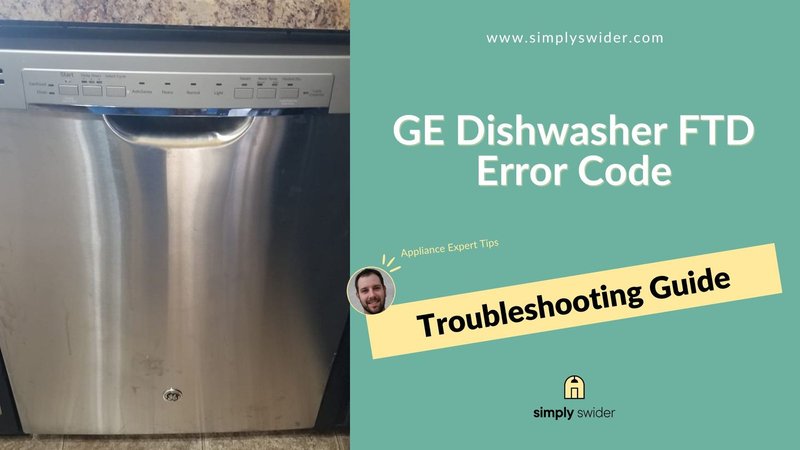
Here’s the deal: error codes in appliances are like the ‘check engine’ light in your car. They don’t tell you exactly what’s wrong, but they do give you a nudge to investigate further. The “SE” error in GE dishwashers usually relates to a sensor error, meaning the machine is having a hard time understanding something about its function. It’s like a GPS that’s lost its signal and doesn’t know which direction to go. But what does this mean for you, the dishwasher owner? Is it safe to keep using your machine, or should you call for backup? Let’s dig into this together.
Understanding the “SE” Error Code
The “SE” code might seem like technical jargon, but it relates to something quite straightforward: a sensor error. Think of it as your dishwasher’s way of saying, “Hey, I’m struggling to read the instructions!” Usually, this sensor monitors your dishwasher’s functions, ensuring everything runs smoothly. When it gets confused, it flashes the SE code to grab your attention.
A sensor error can happen for a number of reasons. Sometimes it might be a simple glitch, like when your smartphone suddenly freezes, and a quick restart fixes it. Other times, the sensor might be genuinely struggling due to a blockage or an electrical problem. Imagine trying to drink a smoothie, but there’s a strawberry stuck in the straw – frustrating, right? In your dishwasher, a blockage could make it hard for the sensor to do its job, leading to that pesky SE code.
So, is it safe to keep using your dishwasher when the SE code appears? In many cases, a quick check to remove any potential blockages or a simple reset might do the trick. However, if the problem persists, it’s a sign that you need to dig a little deeper. Think of it as needing a doctor’s advice when a home remedy doesn’t work. Let’s explore how you might approach this.
Common Causes for the SE Error Code
When you see the SE error, your first instinct might be to panic, but take a breath. More often than not, it’s related to straightforward issues that you can address with a little patience and elbow grease. The causes can range from minor glitches to more severe sensor failures.
One frequent cause is related to connectivity. Sometimes, a cable might be loose or damaged, disrupting the data flow between the control board and the sensor. It’s like trying to watch a movie on a bad internet connection – things get choppy. Check the wiring connections if you’re comfortable doing so, ensuring everything is snug and free from damage.
Another common culprit is a dirty or defective sensor. Over time, grime and grease can build up and affect sensor performance, much like trying to read a book through smudged glasses. Cleaning the sensor or replacing it (if necessary) can often resolve the issue. If cleaning doesn’t help, the problem might lie deeper within the dishwasher’s electronic system.
And then there’s always the possibility of a software hiccup. Dishwashers, like computers, sometimes need a reboot. You can perform a reset by flipping off the circuit breaker for a minute or two and then turning it back on. If this clears the code, it’s like giving your dishwasher a fresh start. However, if the SE code keeps flashing after these attempts, it might be time to call in a professional.
Steps to Address the SE Error Code
What should you do when your dishwasher flashes the SE code? Start simple. First, try turning the dishwasher off and on, like rebooting your computer. This sometimes clears minor glitches. If that doesn’t work, inspect the wiring and connections to ensure they’re secure and free from damage. If you’re comfortable, you can use a multimeter to check for electrical continuity in the sensor circuit – though this might be better left to a professional.
Next, open up the dishwasher and carefully clean around the sensor area. Use a gentle cleaning solution and a soft cloth to remove any dirt or residue. This is like cleaning glasses or that smartphone screen for a clearer view. If cleaning doesn’t help, consider replacing the sensor. It might sound daunting, but with the right guide or a pro on-call, it’s a manageable fix.
If the problem persists, don’t hesitate to contact GE customer service or a certified repair technician. Sometimes, the issue might be more than meets the eye, requiring expert tools and experience to resolve. It’s better to be safe than sorry, especially when dealing with electrical appliances.
Preventative Measures and Conclusion
Prevention is always better than cure. Keeping your dishwasher in tip-top shape means fewer error codes and more peace of mind. Regular maintenance can go a long way in preventing the SE error from reappearing. Periodically clean the interior and ensure that all parts are dry to prevent moisture-related issues.
Routine checks on wiring and connections can also help, ensuring everything stays connected. It’s a bit like checking your car’s oil – regular maintenance keeps everything running smoothly. Additionally, consider running an empty cycle with vinegar every few months to keep sensors and other components clean and free from buildup.
In conclusion, the SE error code is your dishwasher’s way of signaling that it needs a little attention. While it’s generally safe to use the dishwasher with this code, it’s wise to investigate and resolve the underlying issue to prevent potential damage. With some basic troubleshooting and maintenance, you can keep your dishwasher running smoothly and avoid further headaches. Remember, when in doubt, it’s always a good idea to call in a professional to ensure everything is safe and in working order.